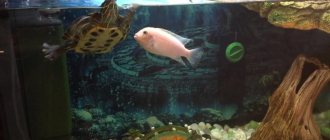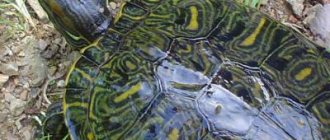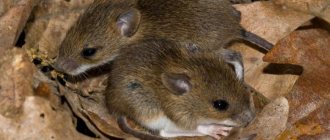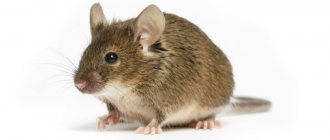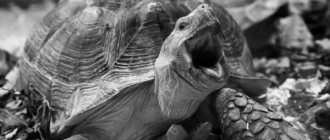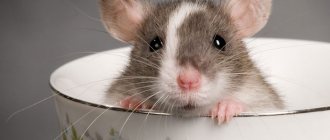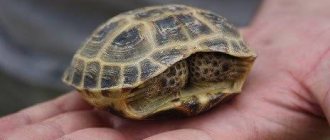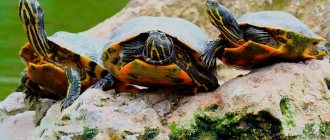Features and habitat of the marsh turtle
A common representative of the class of reptiles is the marsh turtle . The body length of this creature is from 12 to 35 cm, weight is about one and a half kilograms or a little less.
As can be seen in the photo , marsh turtles are not difficult to distinguish from their relatives by the structure of their rounded, low shell, connected on the sides to the lower part of the body by elastic ligaments; as well as by the absence of a beak on the reptile’s muzzle and the following external signs:
- the color of the shell can be black, brown or olive;
- skin covered with yellow spots has a green tint;
- the pupil of orange or yellow eyes is usually dark;
- their legs have membranes and long claws;
- the tail, which acts as a rudder when moving through water, is quite long.
Representatives of the genus of marsh turtles are distributed throughout Europe; they can be found in the Middle East, Turkmenistan, Kazakhstan, the Caucasus, as well as in the northwestern regions of Africa.
Article on the topic: Planting chinchillas: can opposite-sex and same-sex individuals live together in the same cage
They inhabit forests, forest-steppes and mountainous areas, trying to settle near bodies of water; they live not only in swamps, as the name suggests, but in rivers, streams, canals and ponds.
Natural enemies of turtles
Reliable protection in the form of a shell becomes a significant help for turtles, which have many enemies in nature. For example, birds of prey such as hawks and eagles can hunt turtles by dropping them from a height onto rocks. Crows, magpies, and jackdaws are capable of eating young turtles, breaking through the protection of their shells.
The number of natural enemies varies in different regions. For example, in South America, terrestrial turtles are often hunted by jaguars.
Predators can attack several turtles at the same time, eating several species at once. To do this, they turn the turtles on their backs, taking advantage of the flat terrain, where there is no vegetation or stones. Sometimes large rodents, such as mice, prey on turtles.
However, the most dangerous enemies of turtles are people, who often hunt reptiles for turtle eggs and meat.
In addition to people and predators, various viruses, fungi and parasites can become enemies of turtles. Sometimes sick and weak individuals, due to their clumsiness, can become food for ants that can attack the soft parts of reptiles. Sometimes turtles engage in cannibalism, eating their own kind if they cannot resist or escape.
Character and lifestyle of the marsh turtle
These animals, belonging to the family of freshwater turtles, are active during the day and sleep at the bottom of reservoirs at night. They feel great in an aquatic environment, where they can stay for about two days.
But they also feel great on land, so the marsh turtle can be found on large lawns, where these cold-blooded animals love to bask in the sun, thus feeding their body with energy.
The bog turtle feels great both in water and on land
They try to find other suitable places for sunbathing, often using driftwood and stones protruding from the water. Reptiles strive closer to the sun even on cloudy, cool days, despite the cloudy sky, trying to catch the sun's rays breaking through the clouds.
But when the slightest danger arises, the reptiles immediately flop into the water and hide in its depths among the underwater vegetation. The enemies of these creatures can be predatory animals and birds.
Also, they often do not have to expect anything good from humans, and in some eastern countries it is customary to eat them, which causes significant damage to the numbers of the swamp turtle genus.
The sense of smell and vision of such reptiles is well developed. Moving quite quickly on the ground, turtles swim beautifully and quickly, and strong limbs help them in their movements in the water.
The paws of swamp turtles are equipped with large claws, which gives them the ability to easily burrow into a layer of leaves or muddy soil. In the wild, these reptiles hibernate in cold weather. This usually occurs in early November and continues until the end of April.
Article on the topic: The smallest turtles in the world (photo)
Considered quite rare, marsh turtles are included in the Red Book. And although the total number of such animals is quite stable, they have completely disappeared from some habitat areas where they were previously found.
FAQ
Why do turtles hibernate? Turtles are living organisms that are very vulnerable to temperature changes. If weather conditions make the environment too hot or too cold, turtles may hibernate in both summer and winter. To do this, turtles dig a hole for themselves in which they sleep until the temperature changes. Hibernation in turtles can last 4-6 months, usually from December to March. The turtle's thermoregulation system is formed in such a way that the reptile can independently regulate its hibernation time. Most veterinarians agree that while hibernation occurs naturally, it should not be allowed to occur in the home. Therefore, it is important to take care in advance to provide the turtle with the necessary amount of heat and light at any time of the year. Why do turtles have soft shells? Turtles can have problems with their soft shells if they become sick. As a rule, healthy reptiles have a hard, even coating, without dips or unevenness. The soft shell becomes a consequence of rickets, which occurs due to lack of sunlight or improper artificial ultraviolet radiation. Rickets can also develop due to a deficiency of calcium and vitamin D3. This happens if the turtle’s diet is too poor and monotonous. In this case, the tissue of the shell becomes excessively flexible, its deformation occurs even with slight pressure. Why was the turtle called a tortoise? The name turtle comes from the Latin "head", which can be translated as "tile", "brick" or "clay pot". The sound analogue of this name originates from the Proto-Slavic “scoop”, which gradually turned into the modern sound of the word - “turtle”. The Proto-Slavic version, in turn, comes from the word “cherp”, which means “shard”.
Types of marsh turtles
is considered a prominent representative of this genus . She is the owner of a smooth carapace, which has a round or oval shape.
Its color can be greenish-yellow or black with a pattern, dotted with various combinations of rays and lines, as well as white or yellow spots. When wet, the shell changes color as it dries, from shiny in the sun to gradually becoming matte.
The turtle's head is pointed and large, and its skin and paws are dark, dotted with spots. The reptiles weigh about one and a half kilograms and reach approximately 35 cm in size. Moreover, the largest individuals live in Russia.
European marsh turtles are divided into 13 subspecies with different habitats. Individuals differ in appearance, size, color and some other parameters.
Pictured is a European marsh turtle
In Russia, where five subspecies of such reptiles are common, black turtles are mainly found, and individuals with a greenish-yellow shell live under the hot sun of Sicily.
The genus of reptiles described includes another species - the American marsh turtle, which has a carapace 25-27 cm long. The main background of the shell is dark olive, and small light spots are clearly visible on it.
Representatives of the fauna of this species have significant similarities with European marsh turtles in appearance and behavior. For a long time, these two species of animals were considered by scientists to be the same type, but a deeper study of genetics and the structure of the internal skeleton led to the identification of significant differences in these reptiles, which gave reason to now consider them separate species of swamp turtles .
general characteristics
The size and weight characteristics of turtles vary significantly depending on their species. In the tortoiseshell family, you can find both huge representatives of the species, whose weight is more than 900 kg and whose shell size is more than 2.5 meters, and very small turtles, weighing no more than 125 grams with a size of 10 cm.
One of the smallest turtles - Cape Spotted
The main feature of turtles is the presence of a unique shell, which is used to protect turtles from various natural hazards and enemies. The shell of turtles consists of dorsal and abdominal parts. It has very high strength, which allows the turtle to withstand a load of 200 times the weight of the animal.
One of the largest turtles: the leatherback turtle
The dorsal part, called the carapace, consists of an internal armor consisting of bony plates, as well as an external armor consisting of horny shields. Some species of turtles have bony plates covered with thick skin. In turn, the abdominal part, called the plastron, consists of enlarged and ossified ribs, sternum, and clavicles.
A special feature of turtles is the presence of a shell designed to protect the animal from natural enemies. The shell of a turtle consists of a dorsal part (carapace) and a ventral part (plastron). The strength of this protective case is such that it can easily withstand a load exceeding the weight of a turtle by 200 times. The shell consists of two parts: internal armor, consisting of bone plates, and external, consisting of horn shields. In some species of turtles, the bony plates are covered with dense skin. The plastron was formed due to concreting and ossification of the sternum, clavicles and abdominal ribs.
The turtle's head has a pointed shape and medium size, which helps to hide it inside the shell, which, if necessary, becomes a shelter. However, sometimes there are species of turtles with large heads that cannot adapt to the shell.
Features of the way of life indicate that on earth the turtle's eyes are constantly directed to the ground. At the same time, in aquatic representatives of the family, the eyes are located closer to the top of the head, and the gaze is directed downward.
Turtles can periodically mutate, at which point the old skin begins to shed scales from the shell, and at this time the color becomes brighter.
The neck of turtles is quite short, but in some cases its size is comparable to the length of the shell.
Modern turtles do not have teeth; they were present only in ancient turtles that lived at the same time as dinosaurs, but disappeared over time. For biting and chewing food, a powerful beak is used, the surface of which is covered with rough protrusions that replace the teeth of turtles. Their tongue is quite short and is mainly designed for swallowing food, but not for catching food, so it cannot be stuck out.
Care and maintenance of a marsh turtle at home
These reptiles are often kept as pets in their own homes. You can easily buy them or catch them yourself in their habitats, for which the warm summer months are very suitable.
Article on the topic: Leatherback turtle - description with photos
Domestic bog turtles are typically smaller than those found in the wild. Their unpretentiousness allows anyone, even the most inexperienced owners, to keep them and even have offspring from their pets.
Caring for and maintaining swamp turtles does not involve anything complicated. However, strict adherence to certain care conditions is vital for such pets. And the desire to take this creature into your home for entertainment can lead to the most serious consequences for these harmless creatures.
A marsh turtle at home is not able to live fully without sunlight. That is why it is quite possible to let adult healthy individuals go for a walk in the courtyard of their own dacha in warm summer weather, especially if there is a small artificial pond there.
In the photo there is a baby marsh turtle
Such reptiles can be kept in pairs, but caring for a marsh turtle requires an aquarium with a volume of at least one hundred liters, as well as a heating place illuminated by an ultraviolet lamp, which heats the environment to 30 °C and provides the animals with twelve hours of daylight.
Living at home, swamp turtles do not hibernate, and animal owners should know this and not worry about this. The disadvantages of keeping a marsh turtle include its immense aggressiveness. Reptiles are pugnacious to such an extent that they are capable of injuring each other and even biting off their tails.
They are no friendlier to other pets, not tolerating rivals in the house, especially when it comes to fighting for food. They are capable of being cunning and can, if not carefully, be dangerous to small children. However, turtles are quite smart and reward those who feed them with gratitude.
The photo shows a marsh turtle in a home aquarium
Article on the topic: The homeland of the red-eared turtle, how and where did the red-eared turtles appear?
What do turtles eat in the wild?
The diet of turtles is directly related to the species in question and its habitat. Thus, land turtles feed mainly on plant foods, which include fruits, vegetables, grass, mushrooms, and sometimes young shoots of trees. To replenish moisture in the body, land turtles eat succulent parts of plants, but at the same time drink water with pleasure.
To maintain optimal amounts of protein in their bodies, land turtles eat snails, worms, or slugs.
Freshwater and sea turtles are considered predators. Their diet consists of:
- Little fish.
- Frogs.
- Snails.
- Crustaceans.
- Insects.
- Crustaceans.
At the same time, turtles can also eat plant foods. Some species of freshwater turtles eat frogs when young and gradually switch to a plant-based diet as they mature.
Large turtles are able to feed on bird eggs, and some can catch them for food. This, for example, sometimes happens with ducks.
Some species of turtles eat very specific foods. For example, box turtles prefer poisonous mushrooms, and leatherback turtles prefer poisonous jellyfish. This causes their meat to become poisonous, resulting in poisoning for anyone who catches and eats the turtles.
Land turtles are solitary reptiles. They do not have a herd instinct, and the desire to find a mate extends only to the breeding season, after which the partners disperse.
All turtles are slow, a hallmark of many reptiles. In unfavorable environmental conditions, turtles can gather in small groups and hibernate. During hibernation, all life processes in their body gradually slow down, thanks to which they can tolerate different temperature conditions.
Even by human standards, turtles are considered long-lived. I can live much longer than the average person. Consequently, the average lifespan of turtles is 50-150 years.
Turtles show little to no aggression towards people unless they first tease or provoke aggressive behavior. However, some species, such as snapping turtles, may mistake humans for male competitors during mating season, resulting in an attack.
Swamp turtle nutrition
When feeding, turtles become very dirty, so it is best to place them in a separate container while eating. In addition, these reptiles are extremely voracious and prone to overeating, so it should be borne in mind that adult individuals need to be fed only after two days on the third, but young turtles need daily food intake.
What does a marsh turtle eat ? In nature, they feed on snails, mice, crickets, worms and frogs, centipedes and crustaceans, as well as insects, larvae and algae that can be found in the aquatic environment.
Turtles are quite warlike predators, capable of attacking even snakes; they also catch and eat small lizards and chicks of waterfowl. What to feed marsh turtles if they are pets? It is possible to give them chicken and beef heart and liver, and pamper them a little with shrimp.
Live small fish, for example, guppies, are also usually released into the aquarium to feed turtles. Supplements in the form of vitamins and calcium are simply necessary for such pets. In this sense, artificial food containing everything you need is very convenient.
Types of sea turtles
Sea turtles are larger reptiles than their relatives. They are found in the tropics because they are more comfortable in warm water. In northern latitudes, in cold climates, sea turtles are practically not found.
Marine species have well-developed forelimbs, which turtles use as fins. The hind legs are practically not involved in swimming.
Some species of turtles do not have shells, such as leatherback turtles. In water they become very mobile and at the same time develop great speed. Turtles are highly maneuverable and well oriented in the sea. The most famous species of sea turtles:
Leatherback turtles
This species of turtle does not attack people, but can be aggressive if they are deliberately angry.
This is one of the largest species of the turtle order - the size of the reptiles is 2.6 meters and the weight is more than 900 kg. These turtles are omnivores and are considered one of the largest vertebrates. Leatherback turtles are strong enough to break bones with just one bite.
Reproduction and lifespan of the marsh turtle
As soon as they wake up from hibernation, swamp turtles begin the process of reproduction, and at the end of mating games, they lay 12 to 20 eggs in holes dug on land and located near the water. They bury their clutches carefully. Small black turtles weighing no more than 20 grams appear only after two or even three and a half months, so this happens closer to autumn.
Most often, the cubs remain for the winter, burrowing deeper into the ground, while adults usually spend the cold at the bottom of reservoirs. The juveniles feed from the yolk sac located on their abdomen. Raccoon dogs and otters can destroy swamp turtle clutches.
Article on the topic: Turtles from the Red Book of Russia and the World (photo and description)
The lifespan of such reptiles remains largely a mystery to scientists, and so far there is no consensus on this matter. But, like all representatives of the turtle genus, they are long-livers. Experts usually give a figure of 30-50 years, but some biologists believe that marsh turtles, in some cases, can live up to 100 years.
Reproduction of turtles
Depending on the species of turtle and its habitat, mating season can occur at different times. In addition, each representative of turtles has its own characteristics. Males begin an active struggle for the right to mate with a female. Thus, terrestrial individuals strive to turn over the enemy or force him to flee by striking them with their bullets. When aquatic turtles get into a fight, they begin to chase the competitor, beat him and bite him with a sharp sharp beak. After the participant is excluded, the male begins to court the female, at which time he takes a position more convenient for mating.
The male attracts the female by serenading or stroking his front paws.
To lay eggs, females use holes dug in the sand, their own holes, and sometimes crocodile nests. Turtles lay spherical or elliptical eggs. The resulting masonry is covered with earth and then compacted with plastron blows.
Clutch in the shape of a turtle egg
Depending on the turtle species, the number of eggs laid per brood varies greatly and ranges from 1 to 160. The incubation period is approximately 3 months, but in some species it can exceed 6 months. During the mating season, females are capable of producing several litters.
Poll: Have you ever had turtles in your home? Yes, I have 33.33% No, I have never had turtles 66.67% Show results Ratings: 3
Appearance of a marsh turtle
The appearance of this turtle shows its adaptability to life in water - a streamlined shell, powerful, mobile paddle legs. The paws have large claws and membranes; the tail is long (5-6 cm).
Carapace (upper shield) – convex, oval, often wider in the posterior half; its length can reach 25 cm, but usually less - up to 20 cm. The color of the carapace is dark brown, greenish-brown or blackish with a greenish sheen, with yellow spots or stripes. The head, neck, paws and tail are also dotted with small light spots. The general background of the plastron (lower shield) is yellowish or brown, sometimes black in adult individuals. In males the plastron is concave, in females it is convex or flat.
Types of land turtles
Land turtles have tall, protruding shells and thick, pillar-like legs. Their fingers are together, but the small claws can move apart if necessary.
They have protruding body parts, especially the neck and legs, decorated with scales and shields. These turtles range in size from small, 12 cm long, to large, 1.5 m in diameter. Large species of land turtles are found on islands such as the Seychelles.
Land turtles are slow-moving, and it is customary to scare them away by hissing or sudden urination, which occurs due to the large volume of the bladder. In this way, turtles scare away natural enemies.
Land turtles eat plant foods, but they also need plant proteins, so sometimes turtles eat various insects or invertebrates. They are also able to survive without water for a long time using plant sap. The most famous types of land turtles include the following:
Elephant turtle
Galapagos elephant tortoise. This is one of the largest representatives of the species, the size of which can reach 1.8 m and weight - more than 400 kg. In addition, this turtle is considered a long-liver that can live up to 170 years. These turtles are found exclusively in the Galapagos Islands. The shell of turtles is light brown, and mossy lichens appear over time. They have rather large paws, dry skin, hard scales and scutes. The higher the humidity in the climate where turtles live, the higher their shells.
Elastic turtle
Elastic turtle. This species has a rather flat and soft shell, which is formed by thin gills. If necessary, it can be compressed compared to the standard size. The habitat of these turtles is southern Kenya, Tanzania, especially in the rocky hills area.
Wood turtle
This species is common in Canada and the northern United States. The wood turtle is considered a forest species, due to which its coloring is sharp, “like wood.” It is gray with brown areas and a yellow underplate.
Balkan tortoise
The shell of this turtle does not exceed 30 cm, its upper shield resembles a cinnamon shade, on which there are also dark spots. In young animals, the upper shield has a sunny color, which over time becomes less luminous and darker.
Habitats
The marsh turtle is distributed in North-West Africa, in Southern and Central Europe, to Smolensk and Ulyanovsk in the north, in Asia - in the east to the Irgiz River and the lower reaches of the Syrdarya, and in the south - to Iran, Iraq and Asia Minor.
It can be found in forest, forest-steppe and steppe areas. The marsh turtle is quite unpretentious in its choice of habitats and settles in bodies of water with weak currents; also common in lakes and floodplain channels among floodplains.
Article on the topic: Where do turtles live: the habitat of sea and land turtles in the wild
Prefers reservoirs with sloping banks overgrown with reeds, reeds, cattails and other wetland plants.
Features of the lifestyle and behavior of the marsh turtle
Swamp turtles are active mainly during daylight hours. During the day, they bask in the sun on the shores of reservoirs or are in the water. These reptiles are excellent swimmers and divers; they can stay under water for a long time, and in case of danger or during wintering they bury themselves in silt. At night they sleep at the bottom of the reservoir.
The turtle reacts sensitively to the slightest vibrations of the substrate and, in case of danger, rushes almost vertically down into the water, where it can hide at the bottom for 10-15 minutes.
On land, swamp turtles do not move as quickly as in water, where this seemingly clumsy animal displays amazing dexterity and speed. In the summer, while in the water, the turtle comes to the surface to take air into its lungs and puts its head out of the water on average every 15 minutes.
Turtles have well-developed vision and sense of smell. There are cases when turtles on the shore rush into the water when they see a person at a distance of 10-15 m. If you throw live and dead insects into an aquarium, the living, moving insects are eaten first. When eating immobile shellfish, meat, the turtle navigates with the help of smell. They quickly find and eat pieces of meat wrapped in paper and placed in an aquarium.
Turtles may experience seasonal migrations from warm to cold waters and vice versa. In Crimea, for example, in summer they prefer well-warmed reservoirs of stagnant water. In the fall, they migrate to nearby lakes with a large number of springs, which cool the water in the warm season and prevent it from freezing to the bottom in winter. Stray individuals sometimes end up in conditions unusual for them, for example, in sea bays.
Threats to turtles in nature include foxes, raccoon dogs, otters and crows. Predators pose a particular danger to turtle nests.
Article on the topic: European marsh turtle: photo, description, habitat
Turtle diet
The bog turtle is an active, prey-chasing predator. Unlike the Mediterranean, it eats a wide variety of foods. On the shore, the reptile catches insects (most often orthoptera), centipedes; in the water, in addition to aquatic invertebrates, it hunts tadpoles, newts, frogs, and, less often, fish (it is difficult for a turtle to catch healthy and large fish; usually it catches a sick one, simultaneously performing the role of a reservoir orderly).
Sometimes in places where the turtle feeds, you can see floating fish bladders, clearly visible in the dark water of the forest lakes and serving as an indicator of the presence of marsh turtles in the reservoir.
Turtles rarely eat algae and aquatic plants, and in captivity they completely refuse plant food.
Reproduction
Swamp turtles begin breeding at the age of 6-8 years with a shell length of 9-12 cm.
Egg laying extends from May to July inclusive. During the season there are from 1 to 3 clutches, with each clutch containing from 5 to 10 eggs.
The female lays eggs on the shore in a hole up to 10 cm deep, dug in a sandy or clayey substrate. The incubation period depends on temperature conditions and ranges from 2 to 3 months.
Turtles that hatch from eggs usually go into hibernation in the same place where they were born. They crawl to the surface of the earth only the next year.
Wintering
Turtles leave for the winter at the end of October - beginning of November. They winter in ponds. In fairly dense soil at the bottom, the reptiles dig wintering holes and place them on their sides so that the limbs of one side of the body are outside. Such wintering holes are also found on steep banks. In such a case, turtles make a cave underwater, in which they are in a horizontal position relative to the water level, but sideways to the slope. The limbs and head of sleeping marsh turtles are retracted under the carapace.
Article on the topic: Who eats turtles, how does a turtle protect itself from its enemies in nature
In spring, turtles appear on the surface when the air temperature is 6-14 degrees and water temperature is 5-10 degrees.
Swamp turtles can be kept in a spacious aquaterrarium (from 120 liters). They easily learn and get used to taking food from a stick or tweezers - this allows them to keep the water clean longer. The pieces of meat must be such that the turtle can swallow them, otherwise it will begin to tear them with the claws of its front paws and pollute the water. Swallows food in water. In summer it happily eats pond snails.
With good care, these turtles live in captivity for a long time - 25 years or more.
Belgorod turtle named Natasha. Why are redfish dangerous in our nature?
Today, May 23, is World Turtle Day. This reptile has long ceased to be an exotic animal and has found its niche as a pet along with hamsters, parrots and aquarium fish.
But can turtles be compared to, for example, kittens or puppies? Why do people keep reptiles, and how does this hobby most often end? Anastasia Gladkova , a research assistant at the Belogorye State Nature Reserve .
European in the middle zone
– Nastya, let’s start our conversation with the fact that in Belgorod social networks you can find many posts marked “Belgorod turtles”, “turtles on Vezelka”. And our readers began sending to the editor photographs of tortillas basking in a pond, taken in different areas of the region. Let's figure out what kind of turtles we have.
– The European marsh turtle lives in the Belgorod region. In spring, animals come out of hibernation and can be seen basking in the sun near bodies of water or on logs floating in the water.
-What kind of animal is this?
– The size of the turtle is small – up to 23 centimeters. It is colored dark olive or brown-brown. The head, legs and tail are dotted with yellow dots of varying sizes. There are also yellow dots or lines on the shell. The aquatic lifestyle determines the streamlined shape of the shell. Males and females can be distinguished by their long tail and concave plastron. By the way, the plastron is the lower part of the shell. This type of turtle swims and dives well. It is not easy to see it in nature. At the slightest danger, she tries to slip into the water. They begin wintering around October.
– Does the swamp inhabitant harm nature?
– At one time it was really considered a pest of fisheries. They fought with the turtle for a very long time, so much so that later this species had to be protected. But observation of the animal’s life refuted this opinion. Attempts by a marsh turtle to keep up with healthy fish are usually unsuccessful.
– What do they eat then?
– The diet of the swamp turtle consists of invertebrates, mainly beetles, woodlice, nodule, mollusks, frogs and their tadpoles, dead, sick fish, and rarely aquatic plants. It has been proven that in a natural reservoir its role is rather sanitary. Today, the European marsh turtle is included in the list of species of plants, lichens, fungi and animals that require increased protection measures - candidates for inclusion in the Red Book of the Belgorod Region.
– What does this have to do with?
– First of all, with the destruction of biotopes and places suitable for laying eggs. The nests are destroyed by dogs, foxes and people. This animal’s closest relative, the red-eared turtle, also poses a threat. It is easily identified by the red spots on the sides of its head. Research has shown that red shins are displacing native species from warming zones. And an unheated reptile cannot live fully.
“She’s better there!”
“We don’t have red-eared turtles.”
- But they are sold in pet stores. The homeland of these beauties is North America. They end up in water bodies thanks to irresponsible citizens who keep red-eared turtles as pets or as toys for children, and then realize that they cannot cope with the animal. The turtle may bite the baby, or he will get tired of communicating with it. Can you imagine how often household members step on an animal crawling around the apartment? While playing, he may be bitten by a dog or cat, and the draft will cause the poor fellow to develop pneumonia. In the fall, when the heating has not yet been turned on, the reptile simply catches a cold. Adults can’t find anything better than releasing the red ear into the nearest body of water, while convincing themselves and those around them that they are giving it freedom, and “it’s better there.”
- Isn’t that so?
- Of course not. This is a heat-loving species; the northern border of the red ear's range runs through the state of Virginia, where there is a shift in climate from temperate to subtropical. To live in nature, a turtle needs more comfortable conditions than those found in our region. So, when releasing an adult animal into a pond or river in the summer, a person must be aware that most likely it will only survive until winter. Our frosts will kill her.
– You probably shouldn’t buy your baby a turtle as a pet. There are more familiar pets.
– I am sure that keeping the same turtle requires not only love on the part of the owner, but also knowledge of the ecology, biology and physiology of this species. Accordingly, in order to keep an animal properly, to provide it with a spacious aquaterrarium with water filtration, a place for basking, and an ultraviolet lamp, you also need to spend a lot of money.
– Basking – what is it?
– This is the place where your turtle sunbathes every day under ultraviolet lamps and heating devices. As you know, reptiles can increase their body temperature if the appropriate conditions are created. It is for these purposes that they crawl out of the water in the summer and sit on snags, enjoying the warm days. If a child is really interested in nature, then, as a rule, he loves all animals and studies the conditions in which they are kept. On the one hand, he learns about natural processes, on the other, he learns to treat living creatures responsibly. He will be incredibly interested in watching the life of his pet, and the thought of getting rid of the animal will never occur to him.
Invasive red ear
– Nastya, releasing an animal into a reservoir is dangerous not only because it will die?
- Certainly. The red-eared slider is an invasive species. It is included in the list of the hundred most dangerous invasive species, which was compiled by a group of specialists from the International Union for Conservation of Nature.
- What does it mean?
– These are species of living organisms brought from other parts of the Earth to places where they had not lived before, and which begin to actively take root in new territories, displacing the indigenous inhabitants. In world practice, there are cases where imported species destroyed representatives of local fauna and flora. In the Belgorod region, striking examples are the American mink, which replaced the European mink; ash-leaved maple, which has invaded the native vegetation cover. Such species threaten local biodiversity.
– What was the manifestation of the aggressive attack of the red-eared turtle?
– Today, thanks to such “lovers” of nature all over the world, the red-eared turtle has spread across a number of US states, ending up in the waters of Australia, Israel, Germany, Spain, France, Italy, Poland and the Baltic countries. There is evidence of encounters of such turtles in the reservoirs of Moscow, the Leningrad region, the Stavropol Territory, Dagestan, and the Far East. Little Reds are seen in the neighboring Voronezh region and here. The issue of the distribution of the red-eared turtle in our country is being dealt with by specialists from the Severtsov Institute of Ecology and Evolution of the Russian Academy of Sciences.
– If an animal most likely will not survive in nature, why should it be studied?
– The red-eared turtle has features that allow it to establish itself in new habitats and compete with native species. This is omnivorousness, fertility, the ability to live in anaerobic conditions, that is, in the absence of oxygen, at temperatures up to +3°C for three months. And even if the red-eared reptile does not survive the winter, it is able to ruin the existence of the marsh turtle. Also, North American female relatives, especially those kept in poor conditions, can be carriers of infections.
Source
Central Asian tortoise
The only land turtles found in Russia are also called steppe turtles. This species can be found in the region of Kazakhstan and in all territories of Central Asia. At the moment, the species is on the verge of extinction and is listed in the Red Book, so its representatives cannot be found in pet stores. This land turtle has the following features:
- a small brown-yellow shell with dark spots of an indistinct shape - the number of grooves on the scutes corresponds to the age of the animal;
- the diameter of the shell of an adult reaches 25-30 cm (females are larger than males) - growth is observed throughout life;
- the front legs are powerful, with four claws, the hind legs have horny growths;
- the average life expectancy is 30-40 years, the time of puberty for females is 10 years, for males - 6 years;
- hibernation twice a year - includes the winter months and the summer heat period.
Article on the topic: Where and how red-eared turtles live in nature
Central Asians are unpretentious, rarely get sick, are distinguished by their intelligence and interesting behavior, and rarely hibernate when maintaining a home. Such features have made these reptiles very popular pets.
INTERESTING: Soviet Central Asian turtles managed to visit space - in 1968, the Zond 5 research apparatus with two representatives of the species on board circled the Moon, after which it successfully returned to Earth. Both turtles remained alive, only losing 10% of their body weight.
Kaluga region
Bird Park "Sparrows" (Kaluga region)
Species: pig-necked turtle, red-eared turtle, spurback turtle, Amboin turtle
Address: Kaluga region, Zhukovsky district, Village of State Farm "Pobeda" Tel.: 8 (48439) 934 26 Website: www.birdspark.ru
Sadovy (Moscow region)
Species (23): Indochinese Box, Indian Lobate, Cross-breasted, Snake-necked, Decorated Box, Cayman, Common Musk, Bighead, Matamata, Vulture, Two-clawed, Radiant, Charcoal, Spurneck, Leopard, Splendid Forest, Vietnamese Keeled, Carolina, Spiny, Red-bellied short-necked, red-eared, swamp, Chinese trionix
Address: Moscow region, Dolgoprudny st. Vinogradnaya 9R (5 km from the Moscow Ring Road along Dmitrovskoe Highway) Website: https://redniva.ru/
European marsh turtle
In addition to land turtles, aquatic turtles also live in Russia. The most common species is the marsh turtle; its habitat is in the middle regions, characterized by a temperate continental climate. These reptiles prefer to live along the banks of ponds, lakes and swamps, which is why they got their name. The signs of the animal are as follows:
- oval elongated shell of green color;
- color dark green, with yellow splashes;
- the size of an adult is 23-30 cm;
- feeds on insects, which it collects on land under leaves and grass;
These turtles are difficult to notice - when approaching them, individuals immediately dive and hide under the silt. They overwinter in a state of hibernation at the bottom of the reservoir, and wake up in the spring, when the water warms up to +5-10 degrees.
IMPORTANT: In recent years, there has been a decline in the number of the species around the world, which is also facilitated by the rapid spread of the more aggressive omnivorous red-eared turtle.
Range of freshwater turtles
These turtles in nature live only in freshwater bodies of water with relatively clean water - in rivers, lakes or ponds. In the freshwater family, there are 77 species of different turtles ranging in size from small to medium. They are true amphibians, since they are capable of staying for a long time not only in water, but also on land. The most famous turtles are:
The marsh turtle lives in Central and Southern Europe, the Mediterranean and North Africa. It is also found in Russia - the regions of the North Caucasus and Crimea. She prefers small rivers and quiet lakes, backwaters with a muddy bottom, where she can bury herself for the winter. This is a heat-loving animal that winters in ice-free reservoirs. In southern Europe and northern Africa, the reptile remains active throughout the year.
Red-eared turtles live naturally in North and South America:
The caiman species also lives in the United States and along the southern borders of Canada, but this reptile is not found in other territories. The painted turtle lives in the same region.
Pond slider
The homeland of these reptiles is America, where the species is widely used as pets due to its beauty and unpretentiousness. American fashion spread throughout the world, and gradually red-eared turtles became part of the natural fauna of countries with a fairly mild climate. This happened due to the fact that many careless owners released their tired, grown-up pets into the wild. These reptiles are distinguished by the following characteristics:
- color green-yellow, bright red spots on the head near the eyes;
- the size of an adult is about 30 cm (larger representatives are found);
- hibernate when the air temperature drops below -10 degrees;
- They are practically omnivores and are able to feed on any type of protein food, which makes them a serious threat to the biological balance of natural ecosystems.
Article on the topic: Where do turtles live: the habitat of sea and land turtles in the wild
Red-eared turtles were also brought to our country as exotic pets. Until recently, all collisions with representatives of this species in the wild of Russia were also considered accidental and related to domesticated individuals released into the wild. But wild reptiles, as well as their first populations, are increasingly being recorded, so it can be argued that red-eared turtles are found in the southern European regions of our country.
Literature
- Ananyeva N. B., Orlov N. L., Khalikov R. G., Darevsky I. S., Ryabov S. A., Barabanov A. V.
Atlas of reptiles of Northern Eurasia (taxonomic diversity, geographic distribution and conservation status). - St. Petersburg: Zoological Institute of the Russian Academy of Sciences, 2004. - P. 21. - 1000 copies. — ISBN 5-98092-007-2. - Bannikov A. G., Darevsky I. S., Ishchenko V. G., Rustamov A. K., Shcherbak N. N.
Key to amphibians and reptiles of the fauna of the USSR. Textbook manual for students of biology. specialties ped. institutions. - M.: Education, 1977 - P. 73-74. - Gurzhiy A. N.
Aquarium and land turtles. - M.: Delta-M, 1999. P. 74-78. - Zavyalov E.V., Tabachishin V.G., Shlyakhtin G.V.
Modern distribution of reptiles in the north of the Lower Volga region. modern herpetology. 2003. Volume 2. pp. 52-67. - Kurylenko B.G., Verves Yu.G.
Amphibians and lycopes of the fauna of Ukraine: Dovidnik-Viznachnik (Navch. pp.) - K.: Geneza, 1998. - P. 115-119. - Makhlin M. D.
Turtles at your home. - M.: Delta-M, 2000. - P. 35-39. - Orlova V.F., Semenov D.V.
Nature of Russia. Life of animals. Amphibians and reptiles. - M.: "LLC Firm "AST Publishing House", 1999. - P. 131-134. - Pupins M.F., Pupinya A.
Experiences and problems of zooculture of the endangered species in Latvia
Emys orbicularis
L. / Zooculture and biological resources. Materials of the scientific and practical conference. Moscow: T-vo scientific publications KMK. 2005. - Ruchin, A. B., Ryzhov M. K.
Red Book of the Republic of Mordovia: amphibians and reptiles // Natural heritage of Russia: study, monitoring, protection. Mat. intl. scientific conf. Tolyatti 2004. p. 232—233 - Ryzhov M.K.
Finds of a marsh turtle in the Republic of Mordovia // Current problems of herpetology and toxicology. Sat. scientific works Vol. 9. Tolyatti 2006. pp. 159-164. - Life of animals in 7 volumes / Ch. editor V. E. Sokolov.
T. 5. Amphibians and reptiles.
/ A. G. Bannikov, I. S. Darevsky, M. N. Denisova
, etc.;
edited by A. G. Bannikova
- 2nd ed., revised. - M.: Education, 1985. - P. 134-136. - Dinçer Ayaz, Uwe Fritz, Mehmet Kutsay Atatur, Ahmet Mermer, Kerim Cicek, and Murat Aafsar
.
Aspect of Population Structure of the European Pond Turtle ( Emys orbicularis
) in Lake Yayla, Western Anatolia, Turkey. Journal of Herpetology, Vol. 42, No. 3, pp. 518—522, 2008 - G. F. Ficetola, E. Padoa-Schioppa, A. Monti, R. Massa, F. De Bernardi and L. Bottoni
.
The importance of aquatic and terrestrial habitat for the European pond turtle ( Emys orbicularis
): implications for conservation planning and management. Can. J Zool. 82: 1704–1712 (2004). - MAL Zufi, A. Celani, E. Foschi & S. Tripepi
.
Reproductive strategies and body shape in the European pond turtle ( Emys orbicularis
) from contrasting habitats in Italy. Journal of Zoology 271 (2007) 218–224 - M. L. Zuffi, F. Odetti and P. Meozzi
.
Body size and clutch size in the European pond turtle ( Emys orbicularis
) from central Italy. J. Zool., Lond. (1999) 247, 139–143 - P. Lenk, U. Fritz, U. Joger and M. Wink
.
Mitochondrial phylogeography of the European pond turtle, Emys orbicularis
(Linnaeus 1758). Molecular Ecology (1999) 8, 1911–1922 - Slawomir Mitrus
.
Spatial distribution of nests of the European pond turtle, Emys orbicularis
(Reptilia: Testudines: Emydidae), from long-term studies in central Poland. Zoologische Abhandlungen (Dresden) 55, 2006: 95—102 - Uwe Fritz, Tiziano Fattizzo, Daniela Guicking, Sandro Tripepi, Maria Grazia Pennisi, Peter Lenk, Ulrich Joger & Michael Wink
. A new cryptic species of pond turtle from southern Italy, the hottest spot in the range of the genus Emys (Reptilia, Testudines, Emydidae). Zoologica Scripta, Volume 34, Number 4, July 2005, pp. 351—371
Far Eastern turtle
The most rare species to be seen in our country is the Far Eastern tortoise or trionics (also known as Chinese) - the number of the species is so small that it is considered critically endangered. This animal has an unusual appearance:
- round shell with soft edges, diameter up to 25-40 cm;
- color greenish-brown with a yellow tint;
- paws have five webbed toes;
- long neck and elongated proboscis nose with nostrils.
They live along the banks of shallow freshwater bodies of water with weak currents, spending most of their time under water.
The peculiarity of the structure of the nose allows them to expose it above the surface and inhale air without giving away their presence. In Russia, Trionix can be seen in the south of the Far East, the main habitats are the Amur and Khanka regions.
Other types
Russian turtles are officially limited to four species - but sometimes you can find representatives of marine reptiles that have swam beyond the territory of their native range. On the Black Sea coast you can also see a relative of the Central Asian turtle - the Mediterranean, a land species that is also on the verge of extinction.
The Caspian turtle is found in areas close to the Caucasus; this unpretentious animal has gained popularity as an interesting pet.
Sources:
https://givotniymir.ru/bolotnaya-cherepaxa-obraz-zhizni-i-sreda-obitaniya-bolotnoj-cherepaxi/ https://www.krasnouhie.ru/bolotnaya-cherepaxa.html https://homkin.ru/cherepahi /cherepahi-v-prirode/v-rossii.html
Kostroma region
Petting Zoo (Kostroma)
Species: Mediterranean tortoise, red-footed tortoise, snake-necked tortoise, big-headed tortoise, two-clawed tortoise, swamp tortoise, Chinese trionix, black swamp tortoise, leopard tortoise, spur-necked tortoise, Central Asian tortoise, elastic tortoise, matamata
Address: st. Molochnaya Gora, 3 Museum of Nature 3rd floor Website: https://vk.com/kontzoo
